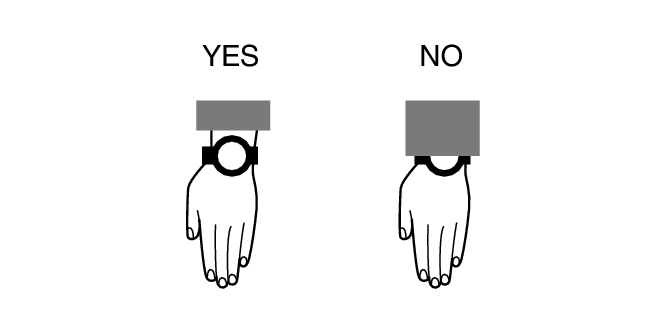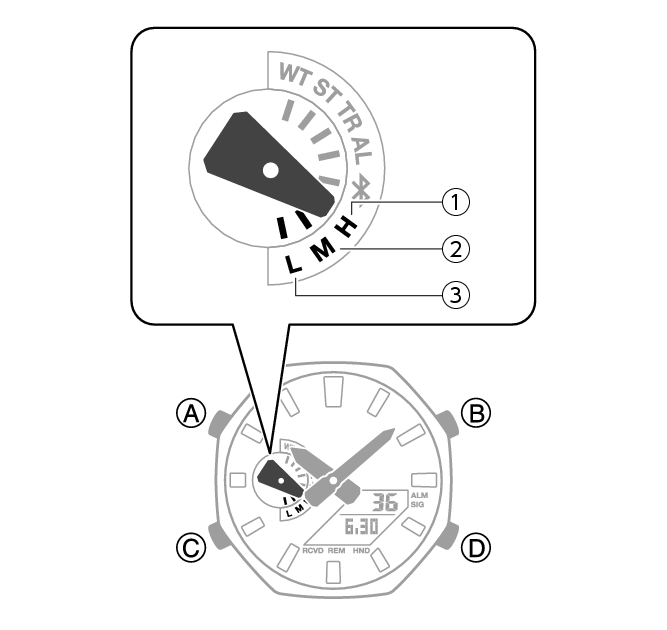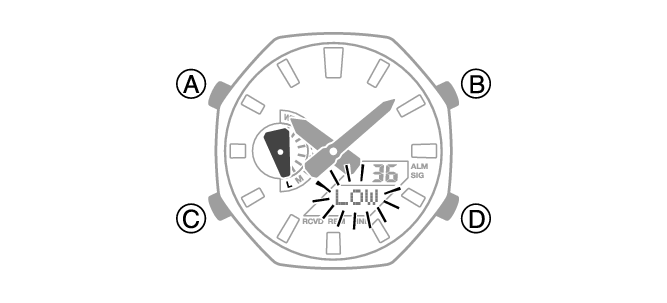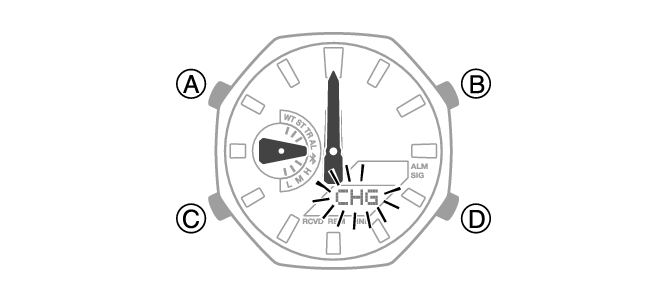Module No. 5689
Charging
This watch runs on power supplied from a rechargeable (secondary) battery that is charged by a solar panel. The solar panel is integrated into the face of the watch, and power is generated whenever the face is exposed to light.
Charging the Watch
When you are not wearing the watch, put it in a location where it is exposed to bright light.

While you are wearing the watch, make sure that its face (solar panel) is not blocked from light by the sleeve of your clothing. Power generation efficiency is reduced even when the face of the watch is blocked only partially.

Important!
Some light sources and environments can cause the watch to become extremely hot during charging, which creates the risk of burn injury and damage to internal watch components.
Avoid charging the watch under conditions like the ones described below, where the temperatures may exceed 60 °C (140 °F).
On the dashboard of a vehicle parked in the sun
Near incandescent lamps, camera lights, halogen lamps, or other sources of heat
In locations exposed to direct sunlight for long periods and other hot locations
Checking the Charge Level
In the Timekeeping Mode, the current charge level is indicated by the mode hand.

-
Good (high charge)
-
Good (medium charge)
-
Low Battery
Low Battery
A low battery will cause [LOW] to flash and will disable the functions below.
Illumination
Sounds (alarm, etc.)
Connection with a phone

If the charge level drops even further, [CHG] will flash and the hour and minute hands will stop at 12 o’clock. If this happens, all functions are disabled.

Dead Battery
The digital display will go blank if the battery goes dead. Memory data is lost, and watch settings are returned to their initial factory defaults.
Important!
Should the battery go low or go dead, expose the face (solar panel) to light as soon as possible.
Exposing the watch to light while its battery is dead will cause [CHG] to start flashing. Expose the watch to light to charge it until the Timekeeping Mode screen re-appears.
Note
If [R] is flashing, it means that all functions, except for timekeeping, are disabled due to high momentary battery power consumption.

Charging Time Guidelines
The table below shows guidelines for approximate charging times.
Charging Times Required for 1 Day of Operation
|
Light Level (Lux) |
Approximate Charging Time |
|---|---|
|
50,000 |
8 minutes |
|
10,000 |
30 minutes |
|
5,000 |
48 minutes |
|
500 |
8 hours |
Times Required to Achieve Next Charge Level
Sunny day, outdoors (50,000 lux)
|
Dead battery |
3 hours |
|
Medium charge |
24 hours |
|
High charge |
7 hours |
Sunny day, near a window (10,000 lux)
|
Dead battery |
7 hours |
|
Medium charge |
92 hours |
|
High charge |
25 hours |
Overcast day, near a window (5,000 lux)
|
Dead battery |
11 hours |
|
Medium charge |
149 hours |
|
High charge |
40 hours |
Indoor fluorescent lighting (500 lux)
|
Dead battery |
148 hours |
|
Medium charge |
- |
|
High charge |
- |
Note
Actual charging time depends on the local charging environment.
Power Saving Function
Leaving the watch in a dark location for about one hour between the hours of 10 p.m. and 6 a.m. will cause the display to go blank, and the watch to enter Level 1 power saving. If the watch is left in this condition for six or seven days, the watch will enter Level 2 power saving.
Power Saving Level 1:
Digital display goes blank to save power. The watch can connect with a phone at this level.
Power Saving Level 2:
All hands stop and the digital display goes blank to save power. All functions are disabled.
Recovering from Power Saving Operation
Use one of the operations below to exit power saving.
Press any button.
Move the watch to a bright location.
Note
You can enable or disable Power Saving.
Note that the watch also may enter power saving if its face is blocked from light by your sleeve while you are wearing it.

 Medium charge
Medium charge